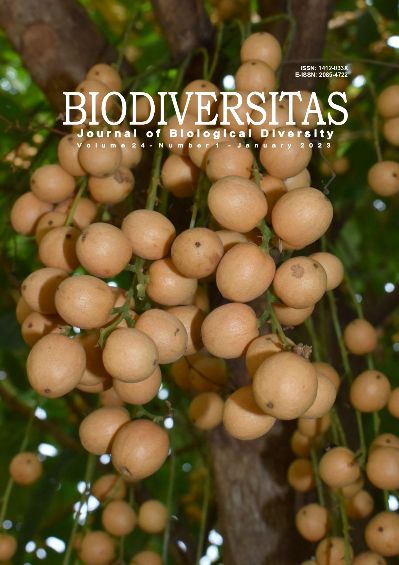Population dynamics of Spirostachys africana Sond. a species highly exploited amongst some communities of Limpopo Province, South Africa
##plugins.themes.bootstrap3.article.main##
Abstract
Abstract. Victor PM, Tshisikhawe MP, Magwede K. 2023. Population dynamics of Spirostachys africana Sond. a species highly exploited amongst some communities of Limpopo Province, South Africa. Biodiversitas 24: 492-497. Over-exploitation of important indigenous plant species impact negatively on their population structure. Unmonitored and unsustainable harvesting from plant ecosystems may inhibit plant recovery. The aim of the study was to investigate the population structure of Spirostachys africana in a communal area of Ha-Matsa Village in Limpopo Province, South Africa. Eleven transects of 100m x 10m were used to sample ecological parameter data from 66 plant specimens of S. africana species. Transects were subjectively placed within the population of S. africana. Data on plant height size classes and basal stem diameter size classes exhibited an almost Bell-shaped population curve. The population of S. africana did not have many seedlings, with the Crown health status data revealing a population with generally moderately damaged crowns (24%), while 19% of individuals had healthy crowns. The concern is the recorded 9% of dead crowns. Although the population looks great from a distance, the sampled ecological data revealed an unviable population. The Spirostachys africana population of Ha-Matsa Village does not have more individuals in the small size classes of both height and basal stem diameter. Conservation practice implies that if anthropogenic activities are not properly monitored, there may not be enough young individuals to support the population of S. africana into the future. Therefore, this study aimed to improve the assessment and the effects of harvesting on the S. africana species population. This study also suggests important information and guides ecologists and conservationists on sustainable harvesting practices and offtakes of S. africana.
##plugins.themes.bootstrap3.article.details##
Most read articles by the same author(s)
- MAKUÉTÉ ANDRÉ PATRICK TIAWOUN, MILINGONI PETER TSHISIKHAWE, EASTONCE TENDAYI GWATA, Investigation of current threats to the existence of Brackenridgea zanguebarica in a small geographic area in Vhembe, Limpopo Province, South Africa , Biodiversitas Journal of Biological Diversity: Vol. 20 No. 6 (2019)

